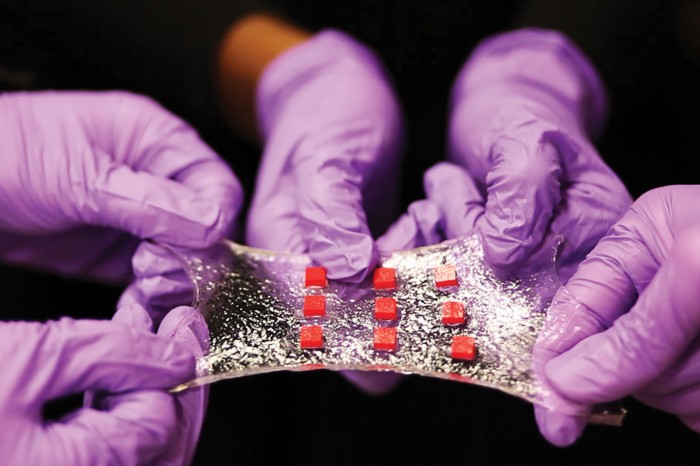MIT engineers have designed what may be the Band-Aid of the future: a sticky, stretchy, gel-like material that can incorporate temperature sensors, LED lights, and other electronics, as well as tiny reservoirs and channels for drug delivery. The material releases medicine in response to changes in skin temperature and can be designed to light up if, say, medicine is running low.
When the dressing is applied to a highly flexible area, such as the elbow or knee, it stretches with the body, keeping the embedded electronics functional and intact.
The key to the design is a hydrogel matrix designed by Xuanhe Zhao, an associate professor of mechanical engineering. The hydrogel is a rubbery material, mostly composed of water, designed to bond strongly to surfaces such as gold, titanium, aluminum, silicon, glass, and ceramic, making it possible to embed electronics.
In the journal Advanced Materials, the team reports embedding electronics such as conductive wires, semiconductor chips, LED lights, and temperature sensors into the hydrogel. Zhao says electronics coated in hydrogel may be used not just on the surface of the skin but also inside the body—for example, as glucose sensors or even neural probes.

Typical synthetic hydrogels are brittle and barely stretchable, and they adhere weakly to other surfaces. To get around these challenges, Zhao’s team came up with a general design strategy for robust hydrogels, mixing water with small amounts of selected biopolymers to create soft, stretchy materials with a stiffness of 10 to 100 kilopascals—about the range of human soft tissues. The researchers also devised a way to strongly bond the hydrogel to various nonporous surfaces.
In the new study, the group embedded electronic temperature sensors and tiny drug reservoirs within a sheet of hydrogel to create what they call a “smart wound dressing.” They also created pathways to allow drugs to flow through the hydrogel, by either inserting patterned tubes or drilling tiny holes through the matrix. They placed the dressing over various regions of the body and found that even when highly stretched, it continued to monitor skin temperature and release drugs according to the sensor readings.
The researchers say an immediate application of the technology may be as a treatment for burns or other skin conditions. Eventually it might be used as a carrier for neural probes or glucose sensors.
“If you want to put electronics in close contact with the human body for applications such as health-care monitoring and drug delivery, it is usually desirable to make the electronic devices soft, wet, and stretchable to fit the environment of the human body,” Zhao says. “That’s the motivation for stretchable hydrogel electronics.”
Keep Reading
Most Popular
Large language models can do jaw-dropping things. But nobody knows exactly why.
And that's a problem. Figuring it out is one of the biggest scientific puzzles of our time and a crucial step towards controlling more powerful future models.
The problem with plug-in hybrids? Their drivers.
Plug-in hybrids are often sold as a transition to EVs, but new data from Europe shows we’re still underestimating the emissions they produce.
Google DeepMind’s new generative model makes Super Mario–like games from scratch
Genie learns how to control games by watching hours and hours of video. It could help train next-gen robots too.
How scientists traced a mysterious covid case back to six toilets
When wastewater surveillance turns into a hunt for a single infected individual, the ethics get tricky.
Stay connected
Get the latest updates from
MIT Technology Review
Discover special offers, top stories, upcoming events, and more.